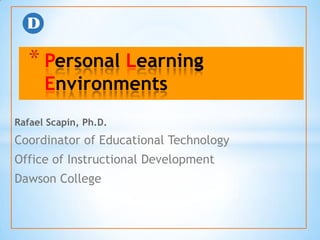Professional studies assingment oj
- 1. * Personal Learning Environments Rafael Scapin, Ph.D. Coordinator of Educational Technology Office of Instructional Development Dawson College
- 2. * Index * Course Management Systems (CMS) * Web 2.0 and Changes in Learning * Connectivism * Introduction to PLEs * Creating your PLE * Conclusions * References * Questions
- 3. * Learning has changed! ? Old way = linear, classroom based ? New way = networks of people and online resources ? The way we find, store, create, critique, and share information has also changed: Information R/evolution
- 4. * Learning has changed! Web 2.0
- 5. *PLE: Definition * In contrast to traditional LMS-driven e-learning solutions, a Personal Learning Environment (PLE) takes a more natural and learner-centric approach and is characterized by the freeform use of a set of lightweight services and tools that belong to and are controlled by individual learners. (Mohamed Amine Chatti , 2009)
- 6. * OAESD, May 2012 Mike Carroll, Superintendent, NCESD Robert Waltenburg, Superintendent, Grant and NCESD Rinda Montgomery Conwell, Assistant Superintendent, NCESD Westley Field, Director of Learning Innovation, Waverley College
- 7. * Participants will know: * The history of the Frontier Learning Network * The goals of Enhancing Learning Options. * The purpose of gaining member schools. * Participants will be able to: * Identify three of the changes theyˇŻd like to pursue * Learn more about how these changes are being implemented. * Interact with iOS devices * Share take awayˇŻs *
- 8. EdTech Teachers Students Technology * Administrators
- 9. http://bit.ly/SteveOnQuestio ning *
- 10. * Mike Carroll, mcarroll@ncesd.k12.or.us Robert Waltenburg, waltenburgr@grantesd.k12.or.us Rinda Montgomery Conwell, rmconwell@ncesd.k12.or.us
- 11. Putting the social media pieces together Jane Hart Social Media & Learning Consultant Centre for Learning & Performance Technologies www.C4LPT.co.uk (c) C4LPT, 2009 11
- 12. Social networks (c) C4LPT, 2009 12
- 13. (c) C4LPT, 2009 13
- 14. File sharing sites Social networks Social bookmarking Communication Blogs and RSS Collaboration (c) C4LPT, 2009 14
- 15. (c) C4LPT, 2009 15
- 16. Advantages Disadvantages self-organising, informal learners address own needs formal learners? competence/confidence best-of-breed tools overwhelming tools social-media aware users hosted services bottom-up approach personal than group learning organisational fear of loss of control * (c) C4LPT, 2009 16
- 17. * Connect, Collaborate, Collect, Contribute Steven Knight ED554 ¨C A2 Marymount University July 2011
- 18. *
- 20. *
- 22. Connect *
- 23. Connect *
- 24. *
- 25. * Lee Rainie, Director, Pew Internet Project 3.26.12 Monterey Institute Email: Lrainie@pewinternet.org Twitter: @Lrainie
- 26. *
- 27. Broadband Pervasive facilitates media networked information Links and multimedia Self-paced learning Analytics
- 28. 56% of adults own laptops ¨C up from 30% in 2006 52% of adults own DVRs ¨C up from 3% in 2002 44% of adults own MP3 players ¨C up from 11% in 2005 42% of adults own game consoles 19% of adults own e-book readers - Kindle 19% of adults own tablet computer - iPad
- 29. * % of cell owners *64% send photo or video *Post video 25% *55% access social net. site *30% watch a video *11% have purchased a product *11% charitable donation by text *60% (of Twitter users) access Twitter 2/22/2011 29
- 30. *What is the future of learning/knowledge? - Shana Ratner (1997) ˇ°Emerging Issues in Learning Communitiesˇ± Old: New: Learning as transactionLearning as a process Knowledge is Knowledge is objective and subjective and certain provisional
- 31. *What is the future of learning/knowledge? -- Shana Ratner (1997) ˇ°Emerging Issues in Learning Old: New: Communitiesˇ± Learning as transaction Learning as a process Our ˇ°intelligenceˇ± Our ˇ°intelligenceˇ± is based on our is based on our individual learning abilities communities
- 32. ? Stanford CS221 ¨C Introduction to Artificial Intelligence ? Sebastian Thrun and Peter Norvig ? Google X, a lab created to incubate the companyˇŻs most ambitious and secretive projects. He was also free to pursue outside ventures. ? In a few slides, heˇŻd spelled out the nine essential components of a university education: admissions, lectures, peer interaction, professor interaction, problem- solving, assignments, exams, deadlines, an d certification.
- 33. Thank you!
- 34. Hurt, J. (n.d.). Putting the social media pieces together. Knight, S. (2011). personal alearning networks . Marymount University. Mike carrol, Robert Waltenburg and Rinda Montgomery. (2012). going global with a collaborative learning network. Westley Field. Rafeal Scapin, P. (n.d.). personal learning environment. Dawson College. Rainie, L. (n.d.). The Shifting Education landscape: Networked Learning. In L. Rainie, networked Learning (p. 3.26.12). monterey institute: pew internet. *


































